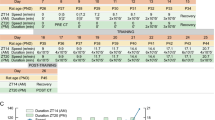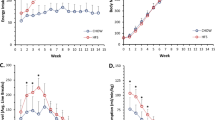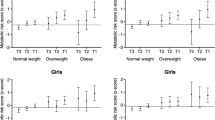Abstract
Objective:
It is unclear whether elevated spontaneous physical activity (SPA, very low-intensity physical activity) positively influences body composition long term. We determined whether SPA and caloric intake were differentially related to the growth curve trajectories of body weight, fat mass (FM) and fat-free mass (FFM) between obesity resistant and Sprague–Dawley rats at specific age intervals.
Design and Subjects:
Body composition, SPA and caloric intake were measured in selectively-bred obesity-resistant and out-bred Sprague–Dawley rats from 1 to 18 months. Data from development throughout maturation were analyzed by longitudinal growth curve modeling to determine the rate and acceleration of body weight, FM- and FFM-gain.
Results:
Obesity-resistant rats had a lower rate of FM gain overall, a lower acceleration in body weight early in life, significantly greater SPA and lower cumulative caloric intake. Greater SPA in obesity-resistant rats was significantly associated with a lower rate of FM gain overall and lower acceleration in body weight early in life. Obesity resistant rats lost less FFM compared with Sprague–Dawley rats despite that obesity-resistant rats had a lower acceleration in FFM gain early in life. Obesity-resistant rats gained less FM and more FFM per gram body weight and were less energy efficient than Sprague–Dawley rats. Caloric intake was significantly and positively related to body weight, FM and FFM gain in both groups. Circadian patterns of caloric intake were group and age-dependent. Our data demonstrate that elevated and sustained SPA during development and over the lifespan are related to the reduced the rate of FM gain and may preserve FFM.
Conclusion:
These data support the idea that SPA level is a reproducible marker that reliably predicts propensity for obesity in rats, and that elevated levels of SPA maintained during the lifespan promote a lean phenotype.
This is a preview of subscription content, access via your institution
Access options
Subscribe to this journal
Receive 12 print issues and online access
$259.00 per year
only $21.58 per issue
Buy this article
- Purchase on Springer Link
- Instant access to full article PDF
Prices may be subject to local taxes which are calculated during checkout





Similar content being viewed by others
References
Westerterp KR, Speakman JR . Physical activity energy expenditure has not declined since the 1980s and matches energy expenditures of wild mammals. Int J Obes (Lond) 2008; 32: 1256–1263.
Monasta L, Batty GD, Cattaneo A, Lutje V, Ronfani L, Van Lenthe FJ et al. Early-life determinants of overweight and obesity: a review of systematic reviews. Obes Rev 2010; 11: 695–708.
Bleich SN, Ku R, Wang YC . Relative contribution of energy intake and energy expenditure to childhood obesity: a review of the literature and directions for future research. Int J Obes (Lond) 2010; e-pub ahead of print 30 November 2010.
Seo DC, Li K . Leisure-time physical activity dose-response effects on obesity among US adults: results from the 1999–2006 National Health and Nutrition Examination Survey. J Epidemiol Community Health 2010; 64: 426–431.
Moore LL, Gao D, Bradlee ML, Cupples LA, Sundarajan-Ramamurti A, Proctor MH et al. Does early physical activity predict body fat change throughout childhood? Prev Med 2003; 37: 10–17.
Proctor MH, Moore LL, Gao D, Cupples LA, Bradlee ML, Hood MY et al. Television viewing and change in body fat from preschool to early adolescence: The Framingham Children's Study. Int J Obes Relat Metab Disord 2003; 27: 827–833.
Gordon-Larsen P, Hou N, Sidney S, Sternfeld B, Lewis CE, Jacobs Jr DR et al. Fifteen-year longitudinal trends in walking patterns and their impact on weight change. Am J Clin Nutr 2009; 89: 19–26.
Westerterp KR, Plasqui G . Physically active lifestyle does not decrease the risk of fattening. PLoS ONE 2009; 4: e4745.
Janz KF, Burns TL, Levy SM . Tracking of activity and sedentary behaviors in childhood: the Iowa Bone Development Study. Am J Prev Med 2005; 29: 171–178.
Janz KF, Kwon S, Letuchy EM, Eichenberger Gilmore JM, Burns TL, Torner JC et al. Sustained effect of early physical activity on body fat mass in older children. Am J Prev Med 2009; 37: 35–40.
Johnson MS, Figueroa-Colon R, Herd SL, Fields DA, Sun M, Hunter GR et al. Aerobic fitness, not energy expenditure, influences subsequent increase in adiposity in black and white children. Pediatrics 2000; 106: E50.
Stevens J, Suchindran C, Ring K, Baggett CD, Jobe JB, Story M et al. Physical activity as a predictor of body composition in American Indian children. Obes Res 2004; 12: 1974–1980.
Levin BE, Dunn-Meynell AA . Chronic exercise lowers the defended body weight gain and adiposity in diet-induced obese rats. Am J Physiol Regul Integr Comp Physiol 2004; 286: R771–R778.
Patterson CM, Dunn-Meynell AA, Levin BE . Three weeks of early-onset exercise prolongs obesity resistance in DIO rats after exercise cessation. Am J Physiol Regul Integr Comp Physiol 2008; 294: R290–R301.
Haskell-Luevano C, Schaub JW, Andreasen A, Haskell KR, Moore MC, Koerper LM et al. Voluntary exercise prevents the obese and diabetic metabolic syndrome of the melanocortin-4 receptor knockout mouse. Faseb J 2009; 23: 642–655.
Bi S, Scott KA, Hyun J, Ladenheim EE, Moran TH . Running wheel activity prevents hyperphagia and obesity in Otsuka long-evans Tokushima Fatty rats: role of hypothalamic signaling. Endocrinology 2005; 146: 1676–1685.
Teske JA, Levine AS, Kuskowski M, Levine JA, Kotz CM . Elevated hypothalamic orexin signaling, sensitivity to orexin A, and spontaneous physical activity in obesity-resistant rats. Am J Physiol Regul Integr Comp Physiol 2006; 291: R889–R899.
Kotz CM, Teske JA, Billington CJ . Neuroregulation of nonexercise activity thermogenesis and obesity resistance. Am J Physiol Regul Integr Comp Physiol 2008; 294: R699–R710.
Thorpe AJ, Kotz CM . Orexin A in the nucleus accumbens stimulates feeding and locomotor activity. Brain Res 2005; 1050: 156–162.
Taicher GZ, Tinsley FC, Reiderman A, Heiman ML . Quantitative magnetic resonance (QMR) method for bone and whole-body-composition analysis. Anal Bioanal Chem 2003; 377: 990–1002.
Nixon JP, Zhang M, Wang C, Kuskowski MA, Novak CM, Levine JA et al. Evaluation of a quantitative magnetic resonance imaging system for whole body composition analysis in rodents. Obesity (Silver Spring) 2010; 18: 1652–1659.
Singer J, Willett J . Applied Longitudinal Data Analysis: Modeling Change and Event Occurrence. Oxford Press: New York, 2003.
Laird NM, Ware JH . Random-effects models for longitudinal data. Biometrics 1982; 38: 963–974.
Suppes T, Webb A, Paul B, Carmody T, Kraemer H, Rush AJ . Clinical outcome in a randomized 1-year trial of clozapine versus treatment as usual for patients with treatment-resistant illness and a history of mania. Am J Psychiatry 1999; 156: 1164–1169.
Bryk AS, Raudenbush SW . Toward a more appropriate conceptualiatio of research on school effects: a three-level hierarchical lineral model. Am J Educ 1987; 97: 65–108.
DeLucia C, Pitts SC . Applications of individual growth curve modeling for pediatric psychology research. J Pediatr Psychol 2006; 31: 1002–1023.
Danner FW . A national longitudinal study of the association between hours of TV viewing and the trajectory of BMI growth among US children. J Pediatr Psychol 2008; 33: 1100–1107.
Littell RC, Milliken GA, Stroup WW, Wolfinger R . SAS System for Mixed Models. SAS Institute, 1996.
Kincaid C . Guidelines for Selecting the Covariance Structure in Mixed Model Analysis. Proceedings of the Thirtieth Annual SAS Users Group International Conference. SAS Institute Inc.: Cary, NC, 2005.
Keselman HJ, Algina J, Kowalchuk RK, Wolfinger R . A comparison of two approaches for selecting covariance structures in the analysis of repeated measurements, 1998. Available from http://home.cc.umanitoba.ca/~kesel/cis1998.pdf.
Nehrenberg DL, Hua K, Estrada-Smith D, Garland Jr T, Pomp D . Voluntary exercise and its effects on body composition depend on genetic selection history. Obesity (Silver Spring) 2009; 17: 1402–1409.
Swallow JG, Wroblewska AK, Waters RP, Renner KJ, Britton SL, Koch LG . Phenotypic and evolutionary plasticity of body composition in rats selectively bred for high endurance capacity. J Appl Physiol 2010; 109: 778–785.
Riddoch CJ, Leary SD, Ness AR, Blair SN, Deere K, Mattocks C et al. Prospective associations between objective measures of physical activity and fat mass in 12–14 year old children: the Avon Longitudinal Study of Parents and Children (ALSPAC). BMJ 2009; 339: b4544.
Roemmich JN, Clark PA, Walter K, Patrie J, Weltman A, Rogol AD . Pubertal alterations in growth and body composition. V. energy expenditure, adiposity, and fat distribution. Am J Physiol Endocrinol Metab 2000; 279: E1426–E1436.
Abbott RA, Davies PS . Habitual physical activity and physical activity intensity: their relation to body composition in 5.0–10.5-y-old children. Eur J Clin Nutr 2004; 58: 285–291.
Dencker M, Thorsson O, Karlsson MK, Lindén C, Eiberg S, Wollmer P et al. Daily physical activity related to body fat in children aged 8–11 years. J Pediatr 2006; 149: 38–42.
Ness AR, Leary SD, Mattocks C, Blair SN, Reilly JJ, Wells J et al. Objectively measured physical activity and fat mass in a large cohort of children. PLoS Med 2007; 4: e97.
Ortega FB, Ruiz JR, Sjostrom M . Physical activity, overweight and central adiposity in Swedish children and adolescents: the European Youth Heart Study. Int J Behav Nutr Phys Act 2007; 4: 61.
Saelens BE, Seeley RJ, van Schaick K, Donnelly LF, O’Brien KJ . Visceral abdominal fat is correlated with whole-body fat and physical activity among 8-y-old children at risk of obesity. Am J Clin Nutr 2007; 85: 46–53.
Berentzen T, Petersen L, Schnohr P, Sørensen TI . Physical activity in leisure-time is not associated with 10-year changes in waist circumference. Scand J Med Sci Sports 2008; 18: 719–727.
Westerterp KR . Physical activity as determinant of daily energy expenditure. Physiol Behav 2008; 93: 1039–1043.
Freedman DS, Khan LK, Serdula MK, Dietz WH, Srinivasan SR, Berenson GS . The relation of childhood BMI to adult adiposity: the Bogalusa Heart Study. Pediatrics 2005; 115: 22–27.
Dietz WH . Periods of risk in childhood for the development of adult obesity—what do we need to learn? J Nutr 1997; 127: 1884S–1886S.
Morley JE . Anorexia in older persons: epidemiology and optimal treatment. Drugs Aging 1996; 8: 134–155.
Blanton CA, Horwitz BA, Murtagh-Mark C, Gietzen DW, Griffey SM, McDonald RB . Meal patterns associated with the age-related decline in food intake in the Fischer 344 rat. Am J Physiol 1998; 275 (5 Pt 2): R1494–R1502.
Horwitz BA, Blanton CA, McDonald RB . Physiologic determinants of the anorexia of aging: insights from animal studies. Annu Rev Nutr 2002; 22: 417–438.
Rosenwasser AM, Boulos Z, Terman M . Circadian organization of food intake and meal patterns in the rat. Physiol Behav 1981; 27: 33–39.
Fonken LK, Workman JL, Walton JC, Weil ZM, Morris JS, Haim A et al. Light at night increases body mass by shifting the time of food intake. Proc Natl Acad Sci USA 2010; 107: 18664–18669.
Marco A, Schroeder M, Weller A . Microstructural pattern of palatable food intake from weaning to adulthood in male and female OLETF rats. Behav Neurosci 2009; 123: 1251–1260.
Zheng H, Shin AC, Lenard NR, Townsend RL, Patterson LM, Sigalet DL et al. Meal patterns, satiety, and food choice in a rat model of Roux-en-Y gastric bypass surgery. Am J Physiol Regul Integr Comp Physiol 2009; 297: R1273–R1282.
Larson NI, Neumark-Sztainer D, Story M . Weight control behaviors and dietary intake among adolescents and young adults: longitudinal findings from Project EAT. J Am Diet Assoc 2009; 109: 1869–1877.
Koletzko B, Toschke AM . Meal patterns and frequencies: do they affect body weight in children and adolescents? Crit Rev Food Sci Nutr 2010; 50: 100–105.
Flegal KM, Graubard BI, Williamson DF, Gail MH . Cause-specific excess deaths associated with underweight, overweight, and obesity. JAMA 2007; 298: 2028–2037.
Finkelstein EA, Brown DS, Wrage LA, Allaire BT, Hoerger TJ . Individual and aggregate years-of-life-lost associated with overweight and obesity. Obesity (Silver Spring) 2010; 18: 333–339.
Ludwig DS . Childhood obesity—the shape of things to come. N Engl J Med 2007; 357: 2325–2327.
van Dam RM, Willett WC, Manson JE, Hu FB . The relationship between overweight in adolescence and premature death in women. Ann Intern Med 2006; 145: 91–97.
Cheng J, Edwards LJ, Maldonado-Molina MM, Komro KA, Muller KE . Real longitudinal data analysis for real people: building a good enough mixed model. Stat Med 2010; 29: 504–520.
Acknowledgements
Funding for this research was provided by the Department of Veterans Affairs, the National Institute of Health (NIDDK R01DK078985 to CMK) and the Minnesota Partnership for Biotechnology and Genomics.
Author information
Authors and Affiliations
Corresponding author
Ethics declarations
Competing interests
The authors declare no conflict of interest.
Additional information
Supplementary Information accompanies the paper on International Journal of Obesity website
Supplementary information
Rights and permissions
About this article
Cite this article
Teske, J., Billington, C., Kuskowski, M. et al. Spontaneous physical activity protects against fat mass gain. Int J Obes 36, 603–613 (2012). https://doi.org/10.1038/ijo.2011.108
Received:
Revised:
Accepted:
Published:
Issue Date:
DOI: https://doi.org/10.1038/ijo.2011.108
Keywords
This article is cited by
-
Hypothalamic control of energy expenditure and thermogenesis
Experimental & Molecular Medicine (2022)
-
Significance of variation in basal metabolic rate in laboratory mice for translational experiments
Journal of Comparative Physiology B (2022)
-
Role of orexin-A in the ventrolateral preoptic area on components of total energy expenditure
International Journal of Obesity (2017)
-
Spontaneous Physical Activity Defends Against Obesity
Current Obesity Reports (2017)
-
Role of orexin receptors in obesity: from cellular to behavioral evidence
International Journal of Obesity (2013)



